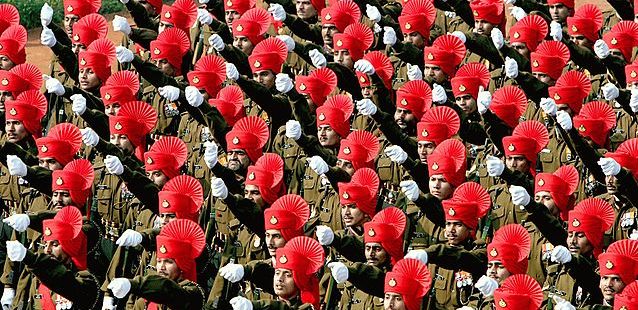India’s Security Not Befitting its Stature

India’s security structure is plagued by shortcomings when it comes to coordinating its substantial capabilities. If it is to live up to its rising political and economic stature, reform must occur soon.
India’s power and interests continue to grow in the Indo-Pacific region and globally, yet its national security policymaking approaches have not kept pace. These may have been barely adequate for India’s 20th century experience as a regional power tending towards strategic restraint, but currently constrain India from being able to harness its considerable national capabilities to protect larger and more complex interests. Many reforms are necessary, but two enabling early steps are recommended now: the creation of a chief of defence staff position to elevate military coordination and authoritative input to policy; and the preparation of a national security strategy to define and guide overall policy.
For a major power in a problematic regional environment, India has generally managed to prosper despite a less-than-coherent approach to its national security. Yet, in the face of myriad challenges, from its nuclear-armed neighbours Pakistan and China through to terrorism, insurgency and resource insecurity, the world’s largest democracy has often fallen short of its potential as a powerful, effective security actor. India may meet some of the criteria of a major power, in that it can withstand coercion by others, but it is not yet clear that, in turn, India is able to act decisively to either shape its strategic environment or make other powerful actors do its bidding.
Some of the failings have been to do with power relativities, particularly in the face of a significantly more capable China, with a much larger economy and defence budget. India’s strategic freedom of action also has been clearly constrained by Pakistan’s nuclear capabilities. New Delhi is deterred by its smaller rival, no matter how much its official pronouncements insist otherwise.
Much of India’s perceived ineffectiveness as a security actor has stemmed not from an intrinsic lack of capacity, or from the strengths of others, but rather from its shortcomings in coordinating, harnessing and deploying its existing capabilities. Hence, India’s national security capacity has often been less than the sum of its parts. Reform has been urged by multiple reviews and inquiries since the 1990s, including those initiated after the Kargil war in 1999 and the Mumbai terrorist attacks in 2008. More recently, though, a chorus of Indian security practitioners and experts has begun to express frustration at the lack of progress in the context of India’s expanding security interests and challenges.
India is on the move but its security system is stuck in the past
There is little question that India’s rise is not a temporary phenomenon. Its economy is projected to sustain a faster rate of growth than China’s for many years to come. India’s defence spending is increasingly commensurate with its growth, and its force structure is beginning to reflect a maritime as well as continental outlook. Notably, India is firmly in the lead as the world’s largest arms importer (a dubious distinction, since this is also a reflection on the failings of its domestic defence industries).
New Delhi has become active in its security-related diplomacy, deepening ties with many powers—but with Japan and the US in particular—and increasingly hedging against Chinese influence in South Asia and beyond. India has also become increasingly pragmatic, creative and ecumenical in its security diplomacy. It has simultaneously deepened ties with Israel, Iran, the United Arab Emirates, France, Australia, Singapore and Vietnam, while maintaining a long-standing defence partnership with Russia.
Domestically, the national security narrative is not a discouraging one: despite frequent small-scale terrorism, India manages to limit incursions from Pakistan and Pakistani-held territory, has avoided a national trauma on the scale of the 2008 Mumbai attacks for almost a decade, and has kept to a manageable level the insurgencies and unrest in Kashmir, its north east states and Naxalite (Maoist) areas of central India.
Yet this situation of merely coping with threats is unsustainable. India’s national interests, the uncertainties of the wider global security landscape and the expectations of the Indian people have continued to grow. Ultimately, India will need an approach to national security that befits its newfound power, status and the vulnerabilities that also accompany them. This will be especially vital as its economy continues to enmesh further with the international system, as it comes to rely more heavily on international partners for infrastructure and investment, as its energy demand continues to rise and as it relies more heavily on partnerships with others to counter risks like terrorism and Chinese maritime assertiveness.
At a minimum, in the years ahead, India will need a more coordinated and disciplined approach to national security that matches the sum of its parts. India does not need to punch above its weight to protect and advance its interests, but it can no longer afford to punch below its weight. Both its weight and its challenges are considerable, but what is missing is sufficient coordination to ensure that the former can manage the latter.
An expanding horizon of risk
The fact that India has coped, one way or another, with its manifold security problems in the past can hardly provide reassurance that its capabilities or institutions are adequate for the future. India’s horizon of risk is growing with respect to the expansion of its interests and the threats it faces.
In terms of day-to-day national security policy considerations, the most salient problem is the constant tension between stability and sovereignty. India lives in a dangerous neighbourhood, incorporating nuclear-armed Pakistan and China, both of which it has fought wars against, and has unresolved border disputes. In particular, there is a need for Indian governments to demonstrate resolve, deterrence and a willingness to retaliate against various transnational and interstate threats:particularly those involving terrorism, conventional force and nuclear weapons.
India also needs to protect its sovereignty, stability and the safety of its citizens from political violence, most notably terrorism and militancy associated with the unresolved India-Pakistan rivalry dating back to partition in 1947. Notably, although Indian public opinion still rates Pakistan as a leading threat, India’s strategic community is increasingly focused on China as posing a more comprehensive set of challenges.
Indian threat perceptions of China ultimately focus on China’s aspiration to become the pre-eminent power in Asia and, at a global level, a peer only to the US. New Delhi sees Beijing as determined to keep India permanently as a second-tier actor, restricted largely to South Asia and the Indian Ocean, and potentially not even able to shape the strategic environment in its own immediate neighbourhood.
Indian defence moving forward
In today’s India, Prime Minister Narendra Modi is notably open to new thinking across a wide range of issues. So far, he has been more cautious in national security reform than in his approach to, say, corruption or the economy. A key question is at what point the leadership may come to accept that India’s need for a much more integrated approach to national security has become urgent. There was regular media speculation throughout 2015, 2016 and into 2017 that, for instance, the Modi government’s creation of a chief of defence staff position would be a matter of time, although it has still not eventuated. Clearly, India requires a national security strategy, and an associated set of integrated policy structures and processes, that is at least the sum of the nation’s very considerable parts.
Professor Rory Medcalf is the head of the National Security College at the Australian National University. He has previously been director of the International Security Program at the Lowy Institute and worked in numerous other roles across government, education and the private sector.
This article is an edited extract from a paper published in the Australian Journal of International Affairs on 2 July 2017. It may be accessed in its unabridged form here.





